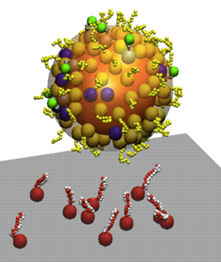Cellular Dynamics
Cellular dynamics and Ordering Principles
Biological cells are able to perform complex tasks such as signal transduction quickly, energy-efficiently and yet in a robust and noise-tolerant manner. For example, in endocytosis, an orchestra of regulatory proteins are involved in collecting a well-defined composition of membrane proteins and are carving a ball of almost perfectly reproducible size out of the membrane, forming an intracellular vesicle that holds a specific cargo. Such a complex process requires many specific molecular complexes to be formed. But how can proteins and ligands find their targets in cellular membranes or cytosol that are extremely crowded with molecules of similar physicochemical signatures such as shape and polarity? So far, it has been mostly assumed that specific functional complexes are formed largely by unbiased diffusion through the cellular compartment. Recent super-resolution microscopy studies have found that proteins can spontaneously form and dissociate clusters on membranes. Do these observations reflect a general principle?
We are developing high-performance computing tools for particle dynamics on a cellular level. Here, individual particles correspond to biomolecules (e.g. proteins or protein domains), which can react with another (e.g. binding, catalysis), and diffuse around in an inter-particle potential (e.g. electrostatics and van der Waals repulsion). This represents an explicit spatiotemporal, single-particle reaction diffusion dynamics. We are working on the simulation of an entire rod cell and the particles involved in the primary vision processes that is initiated by photoexcitation of rhodopsin and leads to a change of membrane potential at the axonal end (around 105 particles and 109 time steps). Furthermore, we investigate mechanisms of exo- and endocytosis in presynaptic neurotransmission. These simulations have high-performance computing requirements that are addressed by implementations on parallel GPU hardware. These efforts contribute to the evolution of a “structural systems biology”, which we believe to become a major branch of computational biology within the next 5-10 years.
Collaborators
Oliver Daumke | MDC Berlin-Buch | Dynamin and endocytosis
Volker Haucke | FMP Berlin-Buch | Clathrin-mediated endocytosis
Klaus-Peter Hofmann | Charité Berlin | Rod cell phototransduction
Benjamin Kaupp | Caesar Bonn | Binding kinetics, supramolecular structure of Rhodopsin
Stephan Sigrist | FU Berlin | Exocytosis and neuronal active zone organization

